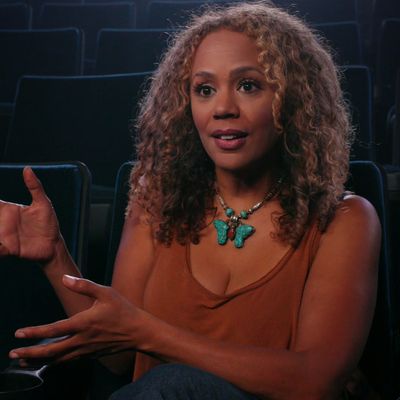
Horror Noire, Shudder’s new documentary about the history of black people in the horror genre, provides an excellent example of how to make cinema history accessible, informative, and even moving for a broader audience. Based on Robin R. Means Coleman’s book Horror Noire: Blacks in American Horror Films From the 1890s to the Present and consisting largely of talking heads (including Coleman herself) and movie clips, the documentary might at first glance seem like it’s going to be a fairly dry, academic affair, but director Xavier Burgin finds ways to keep the discussion conversational and animated, and deploys creative editing techniques to enhance the emotional effect of the topics being tackled.
Interviewing a diverse array of scholars, directors, and actors, Burgin pairs many of his subjects together — Demon Knight director Ernest Dickerson with Tales From the Hood director Rusty Cundieff, for example, or actress Paula Jai Parker with Blacula director William Crain — so that we see and hear their casual interactions with one another. (I think my favorite of these pairings is Dawn of the Dead star Ken Foree with The Thing’s Keith David.) This looseness is crucial because most of the film consists of interviews; the whole thing would become insufferably monotone if everyone simply addressed the camera. The offhand, bull-session-like atmosphere is also simply more engaging; it made me wonder why more documentarians don’t employ this approach.
It’s telling that, in a movie about black horror, it’s not until about midway through the documentary that we get to what was referred to at the time as the first “black horror film,” Blacula; the history recounted in Horror Noire was often overlooked, or considered unimportant, or maybe even deemed too incendiary by many historians, scholars, and critics. As a result, this documentary is as much social history as it is film history, as much a look at form and sensibility as it is a portrait of industrial practice. It starts in the silent era, with the 1915 success of D.W. Griffith’s Birth of a Nation, whose disturbing scenes of a freedman (played by a white actor in blackface) chasing a white woman and then being lynched by the heroically depicted Ku Klux Klan make for a kind of horror film in reverse — the movie was considered a heroic epic at the time, but it plays like a nightmare today. Or, as author Tananarive Due puts it: “Black history is black horror.”
Interviewees connect the response to Griffith’s work with the rise of independent efforts by African-American pioneers Oscar Micheaux and, later, Spencer Williams. The latter, best known as “Andy” on Amos ’n’ Andy, also wrote 1940’s ultra-low-budget monster flick Son of Ingagi, which features as its hero a black female scientist, and offers surprising scenes of ordinary African-American life — a realism born perhaps of the production’s limited means. That the movie is, at least in name, a sequel to the insanely racist “ethnographic” schlock film Ingagi, makes its achievement that much more ironic.
To look at the role that black people have played in the genre — as audiences, protagonists, or defining absences — also requires a certain amount of subtextual analysis. Thus, the 1950s obsession with pseudoscientific tales of the uncanny, and the turn toward movies about the Other, such as aliens and unknown monsters from the beyond, can be read as representing, in filmmaker Monica Suriyage’s words, “all sorts of people that are not white.” Similarly, when Night of the Living Dead shows up in 1968, it’s not only a landmark example of a work that features a charismatic African-American hero, it also winds up subtextually reflecting the violence of its era when Duane Jones’s protagonist is mistaken for a zombie, killed, then burned by a white mob at the end.
These same echoes are expanded near the end of Horror Noire, in an extended discussion of Jordan Peele’s Get Out. Peele himself talks about how Daniel Kaluuya’s protagonist was originally supposed to go to jail, but admits that he changed his mind partly as a response to the dispiriting news at the time about police violence against young black men. Cutting between the horrific finale of Living Dead, the chaos of the ’60s, Black Lives Matter protests, and the triumphant ending of Get Out, director Burgin suggests that certain films cannot only reflect their times but can also rewrite them. It’s through creative, yet vital connections such as these that Horror Noire works its own magic. It’s a lively, occasionally powerful history lesson, and an essential reclamation project.


